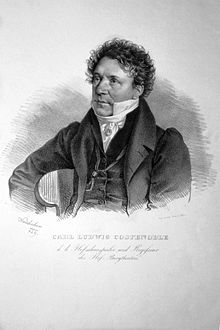Karl Ludwig Costenoble

Karl Ludwig Costenoble , also Carl Ludwig Costenoble , (born December 25, 1769 in Herford , † August 28, 1837 in Prague ) was a German theater actor , director and writer.
Life
Carl Ludwig Costenoble was the son of a reformed cathedral preacher. He evaded his planned appointment as a clergyman by fleeing in Magdeburg . He joined various touring stages as an actor before he received permanent engagements in Bayreuth , Salzburg and finally Hamburg , where he made his debut on March 10, 1801 and played as a crowd favorite until 1818, occupying various subjects from singers to character actors and comedians. His most famous roles included Shylock in Shakespeare's The Merchant of Venice and the friar in Lessing's Nathan the Wise .
In 1818 Costenoble was appointed to the Hofburgtheater in Vienna , of which he was a member until his death. The celebrated actor also worked as a director here. Costenoble died on one of his numerous touring trips on his way home from a guest performance in Hamburg in Prague.
His first marriage was to the actress Johanna Steinhäuser . The sculptor Karl Costenoble was a son from his second marriage. The Viennese folk actress Mizzi Zwerenz was his great-granddaughter .
Costenoble was honored in Vienna by a grave monument in the Vienna Central Cemetery (group 14A, number 50), which the sculptor Parschalk executed in the form of an obelisk and which was unveiled in 1910. In 1908 the Costenoblegasse in Vienna- Hietzing was named after him.
Works
Costenoble also appeared as a writer. Above all, he wrote numerous comedies and plays, which enjoyed great popularity. He also wrote almanacs of dramatic games (1810-16) and diaries, which were published in 1889 under the title Aus dem Burgtheater (1818-37).
literature
- Constantin von Wurzbach : Costenoble, Karl Ludwig . In: Biographisches Lexikon des Kaiserthums Oesterreich . 3rd part. Typogr.-literar.-artist publishing house. Establishment (L. C. Zamarski, C. Dittmarsch & Comp.), Vienna 1858, pp. 19-21 ( digitized version ).
- Joseph Kürschner : Costenoble, Carl Ludwig . In: Allgemeine Deutsche Biographie (ADB). Volume 4, Duncker & Humblot, Leipzig 1876, p. 514 f.
- Ludwig Eisenberg : Large biographical lexicon of the German stage in the XIX. Century . Verlag von Paul List , Leipzig 1903, p. 165, ( Textarchiv - Internet Archive ).
- Alexander von Weilen (ed.): Carl Ludwig Costenoble's diaries from his youth until he moved to Vienna . Society for Theater History, Berlin 1912
- Costenoble via Grillparzer. Unprinted notes from his diaries . Self-published by Alexander von Weilen, Vienna 1915
- Eleonora Schneck: Karl Ludwig Costenoble's life and work at the Vienna Hofburgtheater 1818-1837. With new messages from his diaries . Dissertation. Vienna 1934
- Eckehard Catholy: Costenoble, Carl Ludwig. In: New German Biography (NDB). Volume 3, Duncker & Humblot, Berlin 1957, ISBN 3-428-00184-2 , p. 375 ( digitized version ).
- Costenoble Karl Ludwig. In: Austrian Biographical Lexicon 1815–1950 (ÖBL). Volume 1, Verlag der Österreichischen Akademie der Wissenschaften, Vienna 1957, p. 156.
- Felix Czeike: Historical Lexicon Vienna Vol. 1 . Kremayr & Scheriau, Vienna 1992
Web links
- Entry on Karl Ludwig Costenoble in the Austria Forum (in the AEIOU Austria Lexicon )
- Carl Ludwig Costenoble in the Vienna History Wiki of the City of Vienna
- Literature by and about Karl Ludwig Costenoble in the catalog of the German National Library
- Karl Ludwig Costenoble in the Lexicon of Westphalian Authors
Individual evidence
- ^ Cf. Johann Friedrich Ernst von Brawe: Raisonirendes Journal vom Deutschen Theater zu Hamburg , 23rd piece (March 13, 1801), p. 159ff.
| personal data | |
|---|---|
| SURNAME | Costenoble, Karl Ludwig |
| ALTERNATIVE NAMES | Costenoble, Carl Ludwig |
| BRIEF DESCRIPTION | German actor, director and writer |
| DATE OF BIRTH | December 25, 1769 |
| PLACE OF BIRTH | Herford |
| DATE OF DEATH | August 28, 1837 |
| Place of death | Prague |